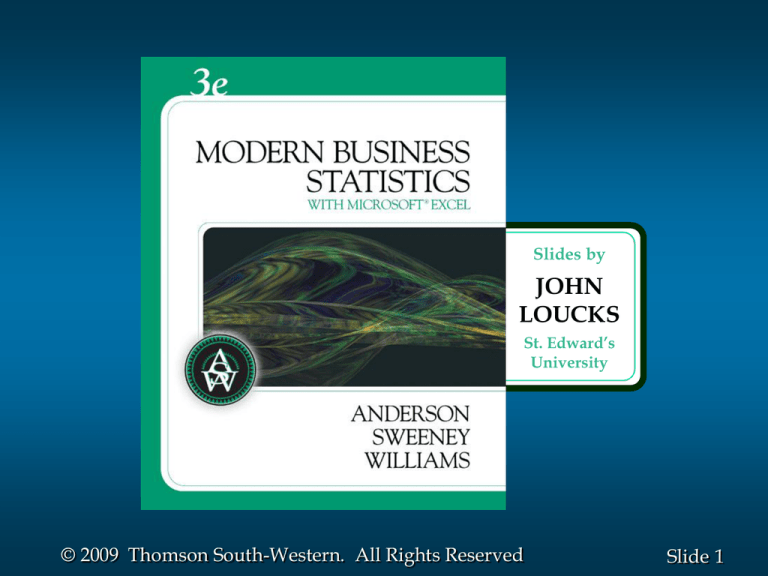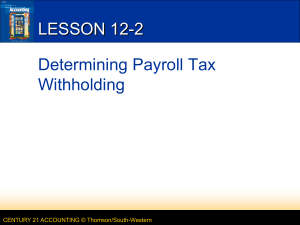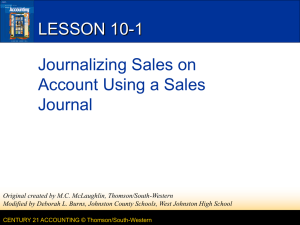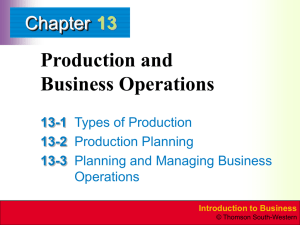
Slides by
JOHN
LOUCKS
St. Edward’s
University
© 2009 Thomson South-Western. All Rights Reserved
Slide 1
Chapter 5
Discrete Probability Distributions
Random Variables
Discrete Probability Distributions
Expected Value and Variance
Binomial Probability Distribution
Poisson Probability Distribution .40
Hypergeometric Probability
.30
Distribution
.20
.10
0
© 2009 Thomson South-Western. All Rights Reserved
1
2
3
4
Slide 2
Random Variables
A random variable is a numerical description of the
outcome of an experiment.
A discrete random variable may assume either a
finite number of values or an infinite sequence of
values.
A continuous random variable may assume any
numerical value in an interval or collection of
intervals.
© 2009 Thomson South-Western. All Rights Reserved
Slide 3
Discrete Random Variable
with a Finite Number of Values
Example: JSL Appliances
Let x = number of TVs sold at the store in one day,
where x can take on 5 values (0, 1, 2, 3, 4)
We can count the TVs sold, and there is a finite
upper limit on the number that might be sold (which
is the number of TVs in stock).
© 2009 Thomson South-Western. All Rights Reserved
Slide 4
Discrete Random Variable
with an Infinite Sequence of Values
Example: JSL Appliances
Let x = number of customers arriving in one day,
where x can take on the values 0, 1, 2, . . .
We can count the customers arriving, but there is
no finite upper limit on the number that might arrive.
© 2009 Thomson South-Western. All Rights Reserved
Slide 5
Random Variables
Question
Family
size
Random Variable x
x = Number of dependents
reported on tax return
Type
Discrete
Distance from x = Distance in miles from
home to store
home to the store site
Continuous
Own dog
or cat
Discrete
x = 1 if own no pet;
= 2 if own dog(s) only;
= 3 if own cat(s) only;
= 4 if own dog(s) and cat(s)
© 2009 Thomson South-Western. All Rights Reserved
Slide 6
Discrete Probability Distributions
The probability distribution for a random variable
describes how probabilities are distributed over
the values of the random variable.
We can describe a discrete probability distribution
with a table, graph, or equation.
© 2009 Thomson South-Western. All Rights Reserved
Slide 7
Discrete Probability Distributions
The probability distribution is defined by a
probability function, denoted by f(x), which provides
the probability for each value of the random variable.
The required conditions for a discrete probability
function are:
f(x) > 0
f(x) = 1
© 2009 Thomson South-Western. All Rights Reserved
Slide 8
Discrete Probability Distributions
Example: JSL Appliances
• Using past data on TV sales, …
• a tabular representation of the probability
distribution for TV sales was developed.
Units Sold
0
1
2
3
4
Number
of Days
80
50
40
10
20
200
x
0
1
2
3
4
© 2009 Thomson South-Western. All Rights Reserved
f(x)
.40
.25
.20
.05
.10
1.00
80/200
Slide 9
Discrete Probability Distributions
Example: JSL Appliances
Graphical
representation
of probability
distribution
Probability
.50
.40
.30
.20
.10
0
1
2
3
4
Values of Random Variable x (TV sales)
© 2009 Thomson South-Western. All Rights Reserved
Slide 10
Discrete Uniform Probability Distribution
The discrete uniform probability distribution is the
simplest example of a discrete probability
distribution given by a formula.
The discrete uniform probability function is
f(x) = 1/n
the values of the
random variable
are equally likely
where:
n = the number of values the random
variable may assume
© 2009 Thomson South-Western. All Rights Reserved
Slide 11
Expected Value and Variance
The expected value, or mean, of a random variable
is a measure of its central location.
E(x) = = xf(x)
The variance summarizes the variability in the
values of a random variable.
Var(x) = 2 = (x - )2f(x)
The standard deviation, , is defined as the positive
square root of the variance.
© 2009 Thomson South-Western. All Rights Reserved
Slide 12
Expected Value
Example: JSL Appliances
x
0
1
2
3
4
f(x)
xf(x)
.40
.00
.25
.25
.20
.40
.05
.15
.10
.40
E(x) = 1.20
expected number of
TVs sold in a day
© 2009 Thomson South-Western. All Rights Reserved
Slide 13
Variance
Example: JSL Appliances
x
x-
0
1
2
3
4
-1.2
-0.2
0.8
1.8
2.8
(x - )2
f(x)
(x - )2f(x)
1.44
0.04
0.64
3.24
7.84
.40
.25
.20
.05
.10
.576
.010
.128
.162
.784
TVs
squared
Variance of daily sales = 2 = 1.660
Standard deviation of daily sales = 1.2884 TVs
© 2009 Thomson South-Western. All Rights Reserved
Slide 14
Using Excel to Compute the Expected
Value, Variance, and Standard Deviation
1
2
3
4
5
6
7
8
9
10
Excel Formula Worksheet
A
Sales
0
1
2
3
4
B
Probability
0.40
0.25
0.20
0.05
0.10
C
Sq.Dev.from Mean
=(A2-$B$8)^2
=(A3-$B$8)^2
=(A4-$B$8)^2
=(A5-$B$8)^2
=(A6-$B$8)^2
Mean =SUMPRODUCT(A2:A6,B2:B6)
Variance =SUMPRODUCT(C2:C6,B2:B6)
Std.Dev. =SQRT(B9)
© 2009 Thomson South-Western. All Rights Reserved
Slide 15
Using Excel to Compute the Expected
Value, Variance, and Standard Deviation
1
2
3
4
5
6
7
8
9
10
Excel Value Worksheet
A
Sales
0
1
2
3
4
B
Probability
0.40
0.25
0.20
0.05
0.10
C
Sq.Dev.from Mean
1.44
0.04
0.64
3.24
7.84
Mean 1.2
Variance 1.66
Std.Dev. 1.2884
© 2009 Thomson South-Western. All Rights Reserved
Slide 16
Binomial Probability Distribution
Four Properties of a Binomial Experiment
1. The experiment consists of a sequence of n
identical trials.
2. Two outcomes, success and failure, are possible
on each trial.
3. The probability of a success, denoted by p, does
not change from trial to trial.
stationarity
assumption
4. The trials are independent.
© 2009 Thomson South-Western. All Rights Reserved
Slide 17
Binomial Probability Distribution
Our interest is in the number of successes
occurring in the n trials.
We let x denote the number of successes
occurring in the n trials.
© 2009 Thomson South-Western. All Rights Reserved
Slide 18
Binomial Probability Distribution
Binomial Probability Function
n!
f (x)
p x (1 p)( n x )
x !(n x )!
where:
f(x) = the probability of x successes in n trials
n = the number of trials
p = the probability of success on any one trial
© 2009 Thomson South-Western. All Rights Reserved
Slide 19
Binomial Probability Distribution
Binomial Probability Function
n!
f (x)
p x (1 p)( n x )
x !(n x )!
Number of experimental
outcomes providing exactly
x successes in n trials
Probability of a particular
sequence of trial outcomes
with x successes in n trials
© 2009 Thomson South-Western. All Rights Reserved
Slide 20
Binomial Probability Distribution
Example: Evans Electronics
Evans is concerned about a low retention rate for
employees. In recent years, management has seen a
turnover of 10% of the hourly employees annually.
Thus, for any hourly employee chosen at random,
management estimates a probability of 0.1 that the
person will not be with the company next year.
© 2009 Thomson South-Western. All Rights Reserved
Slide 21
Binomial Probability Distribution
Example: Evans Electronics
Choosing 3 hourly employees at random, what is
the probability that 1 of them will leave the company
this year?
Let: p = .10, n = 3, x = 1
Using the
probability
function
n!
f ( x)
p x (1 p ) (n x )
x !( n x )!
3!
f (1)
(0.1)1 (0.9)2 3(.1)(.81) .243
1!(3 1)!
© 2009 Thomson South-Western. All Rights Reserved
Slide 22
Binomial Probability Distribution
Example: Evans Electronics
1st Worker
2nd Worker
Leaves (.1)
Leaves
(.1)
Using a tree diagram
3rd Worker
L (.1)
x
3
Prob.
.0010
S (.9)
2
.0090
L (.1)
2
.0090
S (.9)
1
.0810
L (.1)
2
.0090
S (.9)
1
.0810
1
.0810
0
.7290
Stays (.9)
Leaves (.1)
Stays
(.9)
L (.1)
Stays (.9)
S (.9)
© 2009 Thomson South-Western. All Rights Reserved
Slide 23
Using Excel to Compute
Binomial Probabilities
Excel Formula Worksheet
A
1
2
3
4
5
6
7
8
9
x
0
1
2
3
B
3 = Number of Trials (n )
0.1 = Probability of Success (p )
f (x )
=BINOMDIST(A5,$A$1,$A$2,FALSE)
=BINOMDIST(A6,$A$1,$A$2,FALSE)
=BINOMDIST(A7,$A$1,$A$2,FALSE)
=BINOMDIST(A8,$A$1,$A$2,FALSE)
© 2009 Thomson South-Western. All Rights Reserved
Slide 24
Using Excel to Compute
Binomial Probabilities
Excel Value Worksheet
A
1
2
3
4
5
6
7
8
9
x
0
1
2
3
B
3 = Number of Trials (n )
0.1 = Probability of Success (p )
f (x )
0.729
0.243
0.027
0.001
© 2009 Thomson South-Western. All Rights Reserved
Slide 25
Using Excel to Compute
Cumulative Binomial Probabilities
Excel Formula Worksheet
A
1
2
3
4
5
6
7
8
9
x
0
1
2
3
B
3 = Number of Trials (n )
0.1 = Probability of Success (p )
Cumulative Probability
=BINOMDIST(A5,$A$1,$A$2,TRUE)
=BINOMDIST(A6,$A$1,$A$2,TRUE)
=BINOMDIST(A7,$A$1,$A$2,TRUE)
=BINOMDIST(A8,$A$1,$A$2,TRUE)
© 2009 Thomson South-Western. All Rights Reserved
Slide 26
Using Excel to Compute
Cumulative Binomial Probabilities
Excel Value Worksheet
A
1
2
3
4
5
6
7
8
9
x
0
1
2
3
B
3 = Number of Trials (n )
0.1 = Probability of Success (p )
Cumulative Probability
0.729
0.972
0.999
1.000
© 2009 Thomson South-Western. All Rights Reserved
Slide 27
Binomial Probability Distribution
Expected Value
E(x) = = np
Variance
Var(x) = 2 = np(1 p)
Standard Deviation
np(1 p)
© 2009 Thomson South-Western. All Rights Reserved
Slide 28
Binomial Probability Distribution
Example: Evans Electronics
•
Expected Value
E(x) = = 3(.1) = .3 employees out of 3
• Variance
Var(x) = 2 = 3(.1)(.9) = .27
•
Standard Deviation
3(.1)(.9) .52 employees
© 2009 Thomson South-Western. All Rights Reserved
Slide 29
Poisson Probability Distribution
A Poisson distributed random variable is often
useful in estimating the number of occurrences
over a specified interval of time or space
It is a discrete random variable that may assume
an infinite sequence of values (x = 0, 1, 2, . . . ).
© 2009 Thomson South-Western. All Rights Reserved
Slide 30
Poisson Probability Distribution
Examples of a Poisson distributed random variable:
the number of knotholes in 14 linear feet of
pine board
the number of vehicles arriving at a
toll booth in one hour
© 2009 Thomson South-Western. All Rights Reserved
Slide 31
Poisson Probability Distribution
Two Properties of a Poisson Experiment
1. The probability of an occurrence is the same
for any two intervals of equal length.
2. The occurrence or nonoccurrence in any
interval is independent of the occurrence or
nonoccurrence in any other interval.
© 2009 Thomson South-Western. All Rights Reserved
Slide 32
Poisson Probability Distribution
Poisson Probability Function
f ( x)
x e
x!
where:
f(x) = probability of x occurrences in an interval
= mean number of occurrences in an interval
e = 2.71828 In Excel use EXP(1)
© 2009 Thomson South-Western. All Rights Reserved
Slide 33
Poisson Probability Distribution
Example: Mercy Hospital
Patients arrive at the emergency room of Mercy
Hospital at the average rate of 6 per hour on
weekend evenings.
What is the probability of 4 arrivals in 30 minutes
on a weekend evening?
© 2009 Thomson South-Western. All Rights Reserved
Slide 34
Poisson Probability Distribution
Example: Mercy Hospital
= 6/hour = 3/half-hour, x = 4
Using the
probability
function
34 (2.71828)3
f (4)
.1680
4!
© 2009 Thomson South-Western. All Rights Reserved
Slide 35
Poisson Probability Distribution
Example: Mercy Hospital
Poisson Probabilities
Probability
0.25
0.20
actually,
the sequence
continues:
11, 12, …
0.15
0.10
0.05
0.00
0
1
2
3
4
5
6
7
8
9
10
Number of Arrivals in 30 Minutes
© 2009 Thomson South-Western. All Rights Reserved
Slide 36
Poisson Probability Distribution
A property of the Poisson distribution is that
the mean and variance are equal.
=2
© 2009 Thomson South-Western. All Rights Reserved
Slide 37
Poisson Probability Distribution
Example: Mercy Hospital
Variance for Number of Arrivals
During 30-Minute Periods
=2=3
© 2009 Thomson South-Western. All Rights Reserved
Slide 38
Poisson Probability Distributions
The limiting form of the binomial distribution
where the probability of success is small and n is
large is called the Poisson probability distribution
The binomial distribution becomes more skewed
to the right (positive) as the probability of
success become smaller
This distribution describes the number of times
some event occurs during a specified interval
(time, distance, area, or volume)
Examples of use:
Distribution of errors is data entry
Number of scratches in car panels
39
Poisson Probability Experiment
1. The Random Variable is the number of times (counting) some event occurs during a
Defined Interval
Random Variable:
The Random Variable can assume an infinite number of values, however the
probability becomes very small after the first few occurrences (successes)
Defined Interval:
The Defined Interval some kind of “Continuum” such as:
Misspelled words per page ( continuum = per page)
Calls per two hour period ( continuum = per two hour period)
Vehicles per day ( continuum = per day)
Goals per game ( continuum = per game)
Lost bags per flight ( continuum = per flight)
Defaults per 30 year mortgage period ( continuum = per 30 year
mortgage period )
Interval = Continuum
2. The probability of the event is proportional to the size of the interval (the longer the
interval, the larger the probability)
3. The intervals do not overlap and are independent (the number of occurrences in 1
interval does not affect the other intervals
4. When the probability of success is very small and n is large, the Poisson distribution
is a limiting form of the binomial probability distribution (“Law of Improbable Events”)
40
Poisson Probability
Variable
mu
pi
n
X
e
variance
standard deviation
Description
mean = pi*n
Probability of success
Sample Size = # of Trials
Random Variable = # of successes
2.71828182845905 use the formula =EXP(1) to
generate the number e
variance = mu
Square Root of Variance or (pi*n)^(1/2)
In Excel use the POISSON function
41
Poisson Probability Distributions
Variance = Mu
Always positive skew (most of the successes are in the
first few counts (0,1,2,3…)
As mu becomes larger, Poisson becomes more
symmetrical
We can calculate Probability with only knowledge of Mu
and X.
Although using the Binomial Probability Distribution is
still technically correct, we can use the Poisson
Probability Distribution to estimate the Binomial
Probability Distribution when n is large and pi is small
Why? Because as n gets large and pi gets small, the Poisson
and Binomial converge
42
Hypergeometric Probability Distribution
The hypergeometric distribution is closely related
to the binomial distribution.
However, for the hypergeometric distribution:
the trials are not independent, and
the probability of success changes from trial
to trial.
© 2009 Thomson South-Western. All Rights Reserved
Slide 43
Hypergeometric Probability Distribution
Hypergeometric Probability Function
r N r
x n x
f ( x)
N
n
where:
for 0 < x < r
f(x) = probability of x successes in n trials
n = number of trials
N = number of elements in the population
r = number of elements in the population
labeled success
© 2009 Thomson South-Western. All Rights Reserved
Slide 44
Hypergeometric Probability Distribution
Hypergeometric Probability Function
f (x)
r N r
x n x
N
n
number of ways
x successes can be selected
from a total of r successes
in the population
for 0 < x < r
number of ways
n – x failures can be selected
from a total of N – r failures
in the population
number of ways
a sample of size n can be selected
from a population of size N
© 2009 Thomson South-Western. All Rights Reserved
Slide 45
Hypergeometric Probability Distribution
Example: Neveready’s Batteries
Bob Neveready has removed two dead batteries
from a flashlight and inadvertently mingled them
with the two good batteries he intended as
replacements. The four batteries look identical.
Bob now randomly selects two of the four
batteries. What is the probability he selects the two
good batteries?
© 2009 Thomson South-Western. All Rights Reserved
Slide 46
Hypergeometric Probability Distribution
Example: Neveready’s Batteries
Using the
probability
function
r N r 2 2 2! 2!
x n x 2 0 2!0! 0!2!
1 .167
f ( x )
6
N
4
4!
n
2
2!2!
where:
x = 2 = number of good batteries selected
n = 2 = number of batteries selected
N = 4 = number of batteries in total
r = 2 = number of good batteries in total
© 2009 Thomson South-Western. All Rights Reserved
Slide 47
Using Excel to Compute
Hypergeometric Probabilities
Formula Worksheet
A
1
2
3
4
5
6
7
B
2
2
2
4
Number of Successes (x )
Number of Trials (n )
Number of Elements in the Population Labeled Success (r )
Number of Elements in the Population (N )
f (x ) =HYPGEOMDIST(A1,A2,A3,A4)
© 2009 Thomson South-Western. All Rights Reserved
Slide 48
Using Excel to Compute
Hypergeometric Probabilities
Value Worksheet
A
1
2
3
4
5
6
7
B
2
2
2
4
Number of Successes (x )
Number of Trials (n )
Number of Elements in the Population Labeled Success (r )
Number of Elements in the Population (N )
f (x ) 0.1667
© 2009 Thomson South-Western. All Rights Reserved
Slide 49
Hypergeometric Probability Distribution
Mean
r
E ( x) n
N
Variance
r N n
r
Var ( x) n 1
N
N
N
1
2
© 2009 Thomson South-Western. All Rights Reserved
Slide 50
Hypergeometric Probability Distribution
Example: Neveready’s Batteries
• Mean
r
2
n 2 1
N
4
•
Variance
2 2 4 2 1
2 1
.333
4 4 4 1 3
2
© 2009 Thomson South-Western. All Rights Reserved
Slide 51
Hypergeometric Probability Distribution
Consider a hypergeometric distribution with n trials
and let p = (r/n) denote the probability of a success
on the first trial.
If the population size is large, the term (N – n)/(N – 1)
approaches 1.
The expected value and variance can be written
E(x) = np and Var(x) = np(1 – p).
Note that these are the expressions for the expected
value and variance of a binomial distribution.
continued
© 2009 Thomson South-Western. All Rights Reserved
Slide 52
Hypergeometric Probability Distribution
When the population size is large, a hypergeometric
distribution can be approximated by a binomial
distribution with n trials and a probability of success
p = (r/N).
© 2009 Thomson South-Western. All Rights Reserved
Slide 53
Hypergeometric Probability Distribution
Requirements for a Hypergeometric Experiment?
1. An outcome on each trial of an experiment is classified into 1 of 2
mutually exclusive categories: Success or Failure
2. The random variable is the number of counted successes in a fixed
number of trials
3. The trials are not independent (For each new trial, the sample space
changes
4. We assume that we sample from a finite population (number of items in
population is known) without replacement and n/N > 0.05. So, the
probability of a success changes for each trial
N = Number Of Items In Population
n = Number Of Items In Sample = Number Of Trials
S = Number Of Successes In Population
X = Number Of Successes In Sample
54
Hypergeometric Probability Distribution
If the selected items are not returned to the population
and n/N <0.05, then the Binomial Distribution can be
used as a close approximation
In Excel use the HYPGEOMDIST function
55
End of Chapter 5
© 2009 Thomson South-Western. All Rights Reserved
Slide 56










